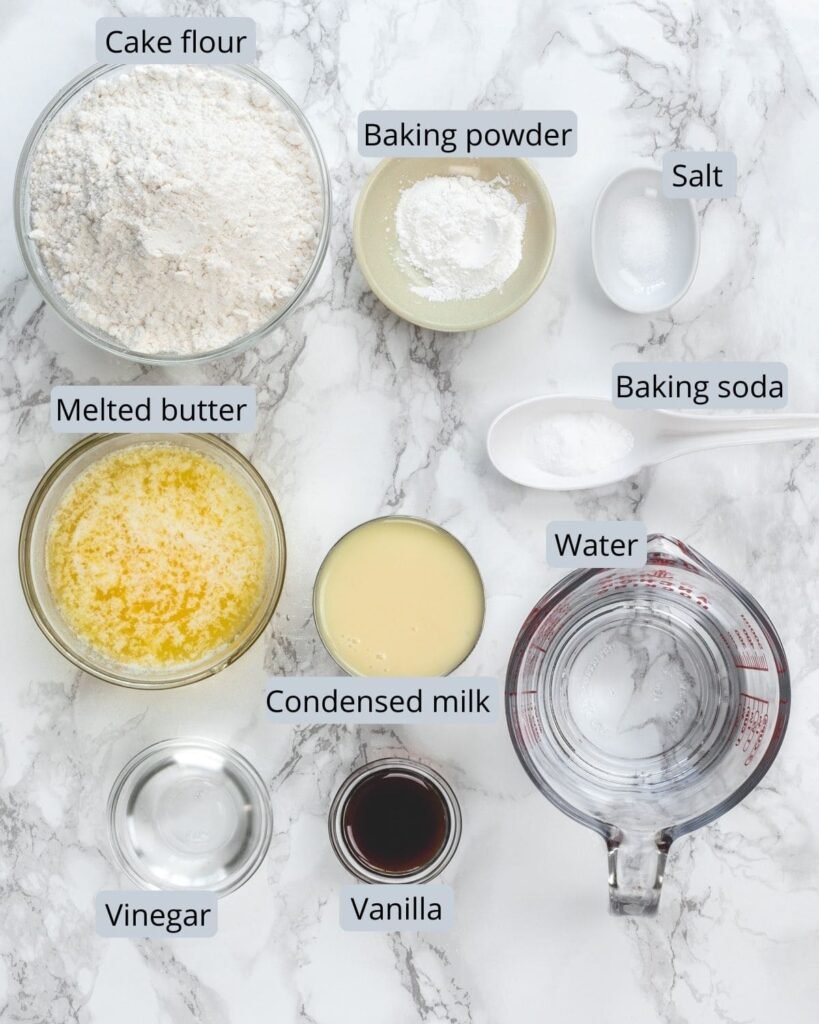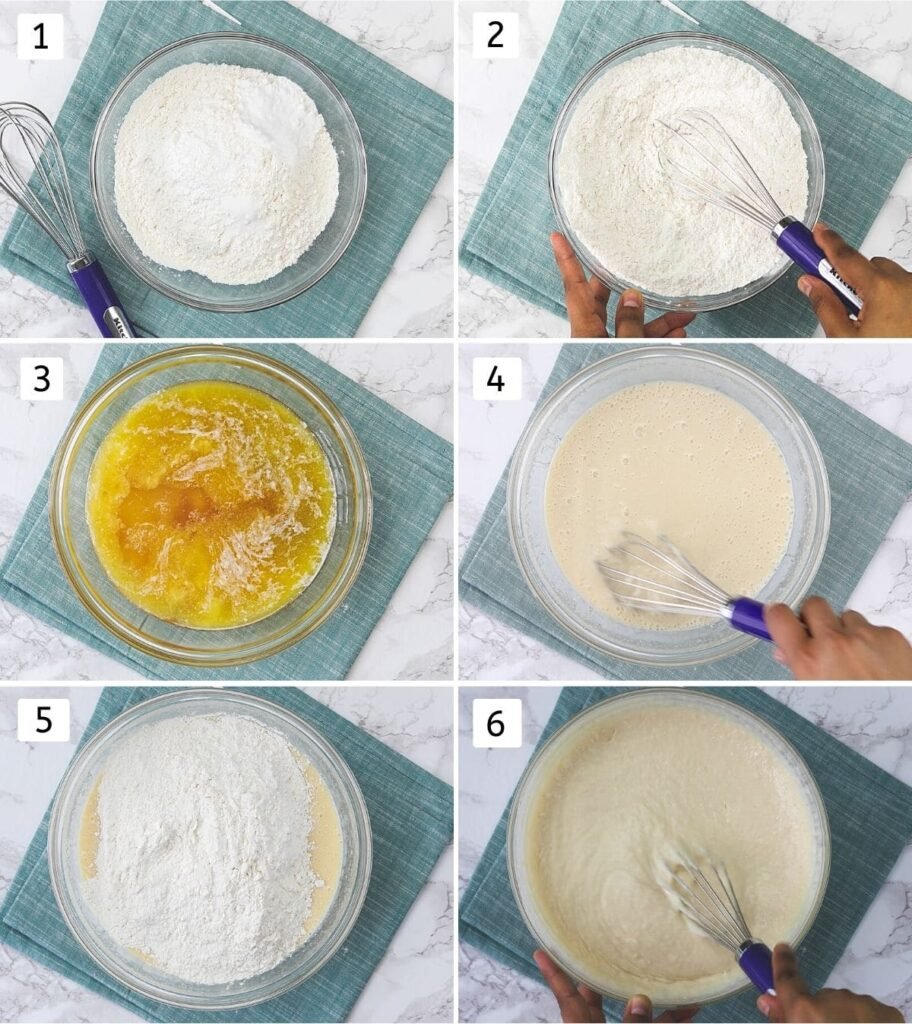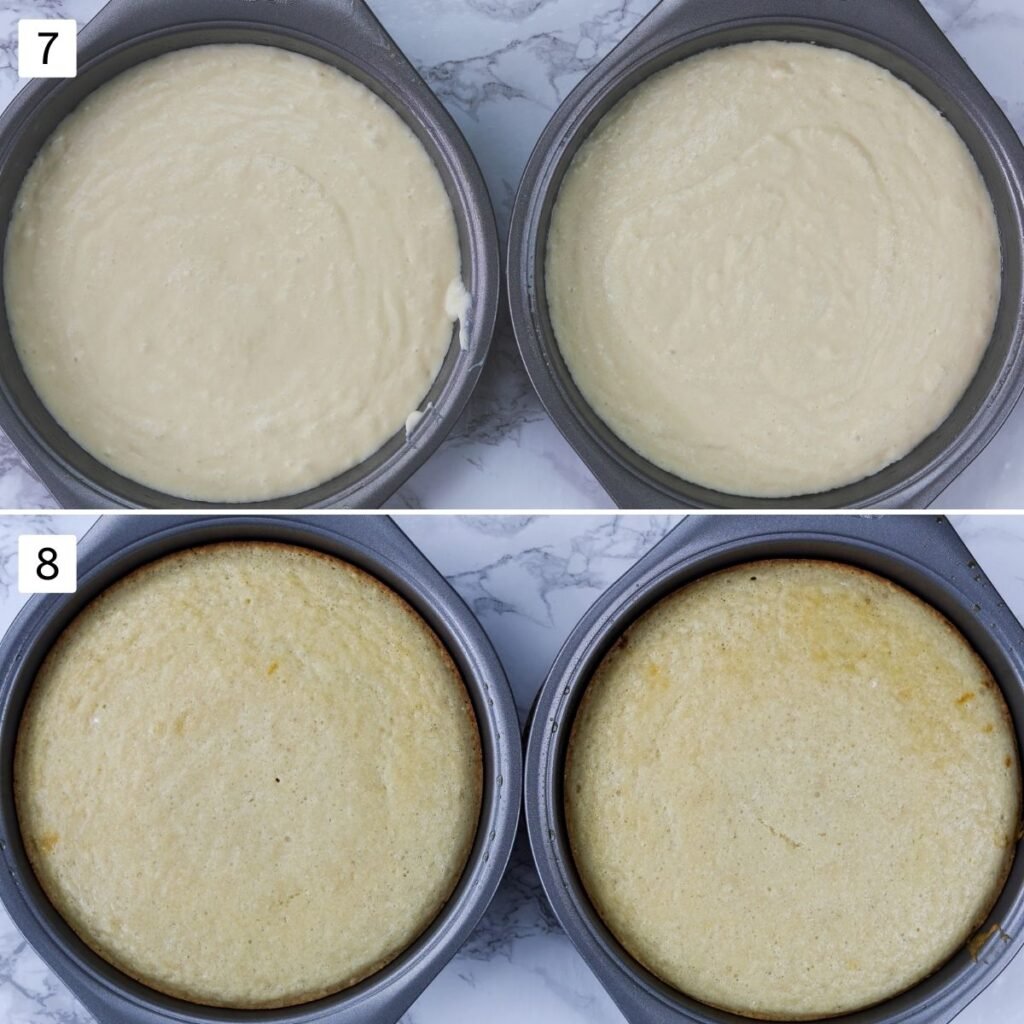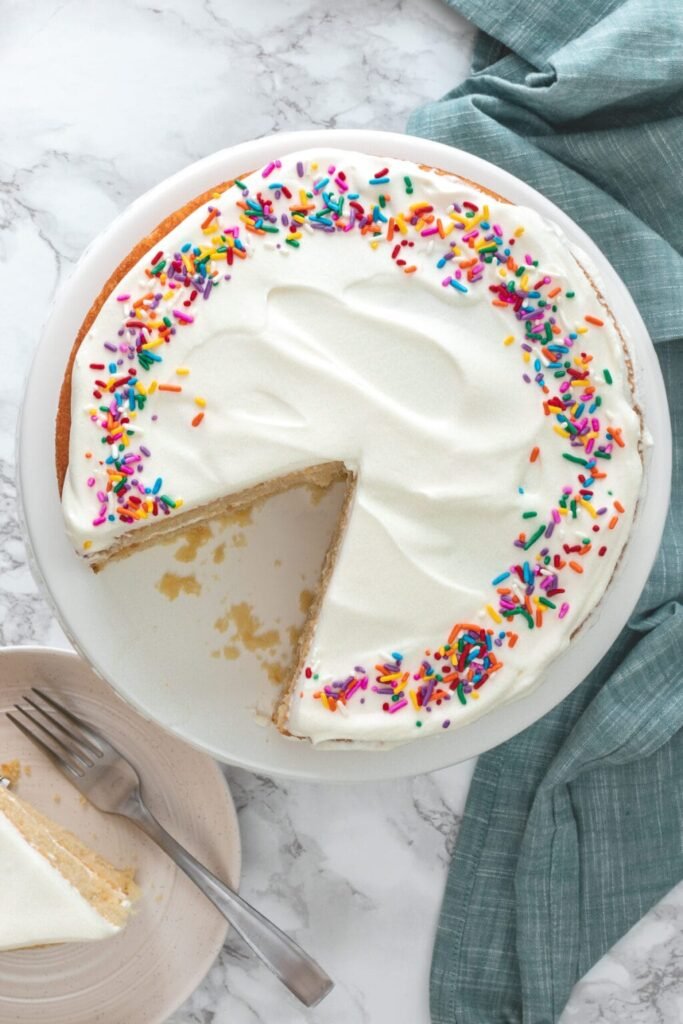This eggless vanilla cake is a true game-changer—simple, delicious, and perfect for any occasion. It’s incredibly soft, tender, and buttery with a moist, spongy crumb that rivals any traditional cake made with eggs.

What sets this recipe apart is its rich vanilla flavor and beautiful golden crust, making every bite a melt-in-the-mouth experience. Despite having no eggs, the texture is light and fluffy, thanks to the perfect balance of ingredients and technique. Whether you’re baking for someone with dietary restrictions or simply ran out of eggs, this cake delivers outstanding results without compromise. In fact, most people won’t even notice it’s eggless—it’s that good. Ideal for birthdays, tea-time treats, or even layered celebration cakes, this is the only eggless vanilla cake recipe you’ll ever need. Once you try it, you’ll keep coming back to it time and time again.
About This Eggless Vanilla Cake Recipe:
- Moist, fluffy crumb: Yes, even without eggs, this recipe gives you a wonderfully soft and airy texture. The cake turns out moist with a delicate crumb that feels light and satisfying—no more settling for dense or gummy results!
- Rich, buttery base with classic vanilla flavor: Every bite is infused with warm, buttery notes and the pure essence of vanilla. It’s simple yet indulgent, and the flavor only gets better with time.
- My go-to recipe for every celebration: Whether it’s a birthday party, festive event, or just a casual family gathering, this eggless vanilla cake always makes an appearance. It’s versatile enough to suit any occasion.
- Made with simple ingredients: You won’t need anything fancy. All the ingredients are everyday kitchen staples—flour, sugar, oil or butter, baking powder, milk or yogurt, and of course, vanilla extract. Just mix, bake, and enjoy!
- Foolproof and flexible: This is one of those reliable recipes that never lets you down. Whether you’re a beginner or seasoned baker, you’ll find this easy to follow. Plus, you can dress it up with frosting, fresh fruits, sprinkles, or leave it plain—it shines either way.
- A timeless classic worth saving: This cake is a definite keeper. You’ll find yourself coming back to it again and again, because it always delivers on taste, texture, and simplicity. Feel free to personalize the cake by adding your favorite mix-ins or toppings—the possibilities for variations are endless.
Ingredient Notes For Vanilla Cake:

- Cake Flour: This recipe relies on cake flour for its signature soft and tender crumb. Unlike all-purpose flour, cake flour has a lower protein content, which means less gluten formation. This results in a finer, lighter texture—ideal for delicate cakes like this one.
- Unsalted Butter: Using unsalted butter allows you to control the amount of salt in the recipe precisely, as salted butter can vary significantly across brands. Always melt the butter first—either in the microwave or on the stovetop—and let it cool to room temperature before using. Adding it while it’s hot can affect the texture of the batter.
- Vanilla Extract: Since vanilla is the primary flavor in this eggless cake, using high-quality pure vanilla extract makes all the difference. Avoid artificial or imitation vanilla essence, which can leave behind a synthetic aftertaste and mask the cake’s natural flavor.
- Sweetened Condensed Milk: This ingredient plays a dual role—it not only sweetens the cake but also acts as a fantastic egg substitute. It lends a rich, creamy texture and helps achieve that moist and soft crumb without the need for eggs.
- Water: Room temperature water is used to bind the ingredients and maintain moisture. It also helps to thin out the batter just enough to ensure even baking and a fluffy texture.
- Vinegar: A small amount of white distilled vinegar is used to react with the baking agents, helping the cake rise and become airy. If you prefer, apple cider vinegar works equally well and adds a subtle fruity note.
How To Make Eggless Vanilla Cake?
- Preheat your oven: Begin by preheating your oven to 350°F (180°C). Allow it to heat for at least 10 minutes, so it’s properly hot when you’re ready to bake.
- Prepare the cake pans: Grease two 9-inch round cake pans using butter or a nonstick cooking spray. You can also line the bottom with parchment paper for easy removal after baking.
1) Combine the dry ingredients
In a large mixing bowl, add the cake flour, baking powder, baking soda, and a pinch of salt. These form the base of your dry mix.
2) Whisk or sift for even mixing
Use a wire whisk to combine all dry ingredients well. Alternatively, you may sift them together to ensure there are no lumps and to incorporate air for a lighter texture.
3) Mix the wet ingredients
In a separate bowl, combine the melted (and cooled) butter, sweetened condensed milk, pure vanilla extract, white vinegar, and room temperature water.
4) Whisk until smooth
Stir the wet ingredients using a whisk until they form a smooth, uniform mixture. This will give your batter the right consistency.
5) Combine wet and dry mixtures
Slowly incorporate the dry ingredient mixture into the bowl of wet ingredients, stirring gently to combine. Whisk gently until just combined. Avoid overmixing, as this can make the cake dense.
6) Divide and fill the pans
Evenly distribute the batter between the two greased cake pans, making sure each pan has a similar amount for uniform baking. Tap the pans lightly on the counter to spread the batter and remove any air bubbles.

7) Bake the cakes
Transfer the pans to the preheated oven and bake for 18 to 20 minutes. To check if they’re fully baked, insert a toothpick into the center—if it comes out clean, the cakes are ready.
8) Cool before frosting
Allow the cakes to sit in the pans for approximately 5 minutes before attempting to remove them. Carefully run a butter knife around the inner edges of the pans to loosen the cakes, then invert them onto a wire rack and let them cool fully. Let them cool completely before frosting or decorating to avoid melting or sliding layers.

Frosting Options:
- Full Frosting for Celebrations: Planning to serve it at a birthday or festive occasion? Frost the entire cake—including the top and sides—for a sleek, party-perfect finish.
- Casual “Naked” Look: For a relaxed or rustic vibe, simply spread frosting over the top and leave the sides unfrosted. It’s perfect for casual gatherings or afternoon tea.
- Classic Buttercream Frosting: Buttercream is a classic option that brings a smooth, sweet, and creamy finish to your cake. Fluffy, rich, and easy to flavor or color as desired.
- Chocolate Fudge Frosting: Inspired by my eggless chocolate cupcakes, this rich frosting is made from butter, powdered sugar, and melted chocolate—perfect for chocolate lovers.
- Chocolate Whipped Cream: Combine 1 cup heavy cream, 2 tablespoons sugar, and 1 tablespoon cocoa powder. Whip until soft peaks form. It gives a light, airy texture with a mild chocolate flavor.
- Plain Whipped Cream with Sprinkles: Light and versatile, whipped cream works beautifully on its own. Add colorful sprinkles for a festive finish.
- Chocolate Ganache: Ideal for a single-layer cake. Drizzle warm ganache over the top for a glossy, decadent touch. (See my eggless chocolate cake for the full ganache recipe.)
- Whipped Cream & Fresh Berries: Top with a swirl of cream and your choice of fresh berries for a refreshing, fruity presentation.
- Keep It Simple: No frosting? No problem. Just dust with powdered sugar—this cake is so flavorful it stands on its own.
- Jam Glaze: Gently warm your favorite jam and spread a thin layer on top. A quick, fruity finish for single-layer cakes.
Expert Tips For the BEST Eggless Cake:
- Condensed Milk is Irreplaceable: Many readers ask for alternatives, but in this particular eggless vanilla cake, condensed milk plays a crucial role in both sweetness and texture. Substituting it will change the final result.
- Adjusting Sweetness: The recipe yields a perfectly sweet cake for most palates without any extra sugar. However, if you prefer your cake sweeter, feel free to add 2–3 tablespoons of sugar along with the condensed milk.
- DIY Cake Flour Substitute: Don’t have cake flour on hand? No problem. Make your own by combining 2 cups of all-purpose flour with 6 tablespoons of packed corn starch. This mix will yield the equivalent of 2½ cups of cake flour needed for the recipe.
- Using Salted Butter?: If you’re opting for salted butter instead of unsalted, simply omit the additional salt listed in the recipe to maintain flavor balance.
- Making a Single-Layer Cake: This recipe can easily be halved to prepare a smaller, single-layer version. Use one baking pan, and the temperature and baking time will remain the same.
- Turn it into a Funfetti Cake: For a colorful and festive twist, stir in ½ cup of rainbow sprinkles to the batter before baking. It’s an instant hit for birthdays and celebrations!

Storage Instructions For Vanilla Cake:
- Use an Airtight Container: Keep your cake fresh by storing it in a sealed container, like a cake carrier or a tight-lid box, to prevent it from drying out.
- Room Temperature Storage: If your climate is cool and dry, the cake can safely sit at room temperature for 1–2 days. Just ensure it’s stored away from heat and direct sunlight.
- Refrigeration Guidelines: For longer shelf life, refrigerate the cake. The cake remains fresh for about 4 to 5 days when refrigerated. However, chilling causes the butter to solidify, resulting in a firmer, denser texture.
- Serving Tip After Refrigeration: Before serving, allow the cake to come to room temperature. This helps restore its original soft, moist, and fluffy crumb—just like when it was freshly baked.
